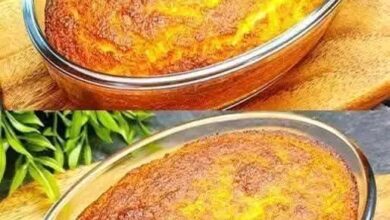Mousse au Citron (French Lemon Mousse)

Mousse au Citron (French Lemon Mousse)
Introduction
“On dit que c’est un dessert d’été ? Moi, ma mousse au citron, je la fais toute l’année !”
This airy and tangy lemon mousse is a timeless French dessert that balances the bright acidity of citrus with the smoothness of whipped cream and egg whites. While often associated with warm, sunny afternoons, its refreshing flavor makes it irresistible year-round — a little jar of happiness to lift your spirits in any season.
Ingredients & Quantities (Serves 4–6)
Ingredient Quantity
Fresh lemons (preferably unwaxed) 3 (about 150 ml juice + zest of 2 lemons)
Large eggs 3 (separated)
Sugar 100 g (½ cup)
Heavy cream (minimum 30% fat) 200 ml
A pinch of salt –
Optional: lemon zest curls, mint leaves, or berries For garnish
Instructions
1. Prepare the lemons:
Wash and zest two lemons finely. Juice all three to get about 150 ml of fresh lemon juice.
2. Make the lemon base:
In a heatproof bowl, whisk together egg yolks, sugar, lemon juice, and zest.
Place the bowl over a pan of simmering water (bain-marie) and whisk constantly until the mixture thickens (about 8–10 minutes).
3. Cool the base:
Remove from heat and let cool completely. You can place plastic wrap directly on the surface to prevent a skin from forming.
4. Whip the cream:
In a separate bowl, beat the heavy cream until soft peaks form. Refrigerate until needed.
5. Beat the egg whites:
In another clean bowl, beat the egg whites with a pinch of salt until stiff peaks form.
6. Assemble the mousse:
Gently fold the whipped cream into the cooled lemon mixture, followed by the egg whites. Work delicately to preserve the airy texture.
7. Chill:
Spoon into individual glasses or ramekins and refrigerate for at least 3 hours, preferably overnight.
8. Serve:
Garnish with lemon zest curls, mint, or a few fresh berries before serving.
Origin and Cultural Significance
Lemon mousse originates from French haute pâtisserie, where light, airy textures became popular in the 18th century as techniques for whipping egg whites evolved.
In France, “mousse” literally means “foam” — symbolizing refinement, elegance, and mastery of texture. Lemon versions became especially loved in southern regions like Provence and the Côte d’Azur, where citrus fruits thrive.
Today, mousse au citron embodies the French art of simple sophistication — minimal ingredients, perfect balance, and pleasure in every bite.
Description
Creamy yet cloudlike, tart yet sweet — each spoonful melts on the tongue. The lemon’s brightness awakens the palate, while the cream and eggs create a silky smooth finish. It’s both comforting and revitalizing, ideal after a rich meal or as a light treat with coffee or tea.
Optional Additions
Herbal note: Add a hint of basil, thyme, or lemongrass zest for a modern twist.
Textural contrast: Serve over a biscuit crumble or with crushed meringue.
Boozy delight: Fold in a teaspoon of Limoncello or Cointreau for adult indulgence.
Vegan version: Replace eggs and cream with aquafaba (chickpea water) and coconut cream.
Tips for Success
Fresh lemons only: Bottled juice lacks the essential zest oils.
Cool base properly: If it’s warm, it will deflate your whipped cream.
Don’t overfold: Gentle movements preserve the airy mousse texture.
Chill thoroughly: Time in the fridge deepens flavor and stabilizes texture.
Nutritional Information (Approx. per serving)
(for 6 servings)
Calories: 220 kcal
Protein: 4 g
Fat: 15 g
Carbohydrates: 18 g
Sugars: 17 g
Vitamin C: 35% of daily value
Light, refreshing, and far less heavy than most cream-based desserts.
Conclusion
Mousse au citron is a celebration of simplicity and balance — a French dessert that embodies sunshine and refinement. Whether served after a festive meal or enjoyed alone on a quiet evening, its bright tang and featherlight texture never fail to enchant.
Recommendation
Pair it with a crisp Sauternes, Champagne, or simply a hot espresso.
Serve it in delicate glass cups for an elegant touch or rustic jars for a cozy homemade look.
Embracing Healthful Indulgence
This dessert is proof that indulgence need not be heavy or guilty. By choosing fresh, natural ingredients and mindful portions, you embrace both pleasure and well-being — the true French approach to dessert.
Would you like me to format this beautifully as a printable recipe card (PDF or Word style layout) with headings, spacing, and a touch of design (like for a cookbook or website)?



